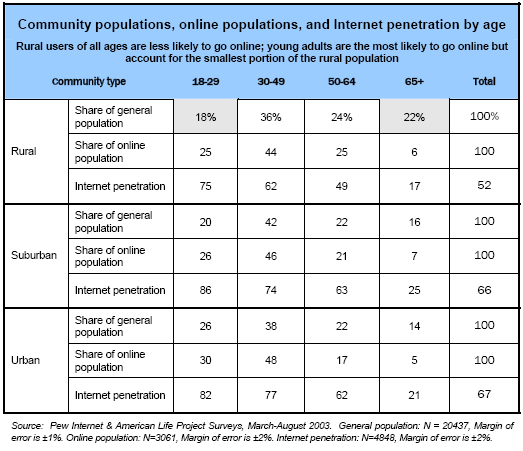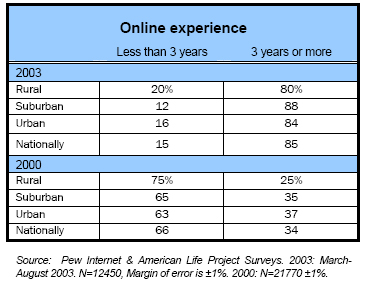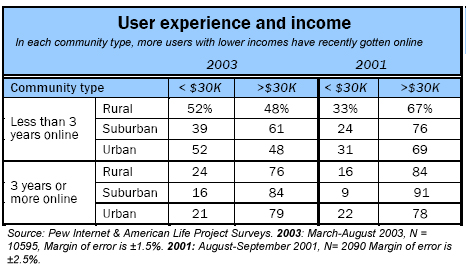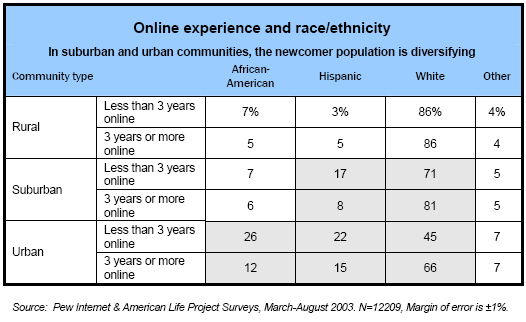The type of community in which a person lives is not a very significant predictor for Internet use. Age, income and educational attainment are stronger.
Rural communities differ significantly from urban and suburban areas in terms of demographics such as age, income and educational attainment. These variables, among others, are strong predictors for Internet use. Statistical analysis that examines the principal drivers for differences in Internet penetration by geographical type suggests that some of the differences are driven by Internet adoption patterns among low-income rural individuals. Living in a rural area in itself has little or no influence as to whether one goes online. However, low-income people in rural areas are less likely to be online than low-income people living in urban or suburban areas; Internet adoption among middle and upper income people is similar across community type.7 Regression analysis shows that, in some (but not all) model specifications, living in a rural area is a modestly negative and significant predictor of Internet adoption at the 10% level of significance. The interaction of income and being a rural resident is, however, significant; this means that the significance on Net adoption of living in a rural area varies by income level. This is the basis for the finding that low-income residents of rural areas are less likely to be online than low-income residents of urban or suburban locations.] In each community type, Internet users are evenly split in terms of sex.
Rural residents are older than suburban and urban residents, and this probably affects Internet penetration rates.
Regardless of community type, younger Americans are more likely than their elders to go online. In all community types, seniors are the least likely to go online. While seniors account for about 17% of the total population, they account for less than 6% of all Internet users.
The rural population is older than that of the suburbs and the cities. Rural populations are composed of a higher percentage of residents 65+ (22%) than are suburban (16%) or urban (14%) populations. In rural communities, seniors account for 22% of the population and about 6% of rural Internet users. Furthermore, rural seniors are less likely to go online than seniors in urban and suburban communities. About 17% of rural seniors go online. By comparison, 21% of urban seniors and 25% of suburban seniors do so.
Young adults are more likely to go online than middle-aged adults and seniors, but there are fewer young adults in rural areas.
In each community type, 18-29 year olds are the most likely to be online. Three quarters of rural 18-29 year olds go online. Only urban adults 30-49 and 18-29 year olds in suburban and urban areas go online more often. But while a large percentage of rural young adults go online — nearly equal to their peers in the cities and the suburbs — young adults are the smallest age group in rural communities. Young adults account for about 18% of the rural population. By comparison, young adults account for 26% and 20% of the urban and suburban populations, respectively.

Educational attainment is associated with Internet use in rural communities as elsewhere.
In each community type, the likelihood of a person going online surges with each level of educational attainment. Significant increases in Internet penetration accompany increasing levels of educational attainment until leveling off after completion of a four-year degree. Once exposed to some college education, the likelihood of a rural resident going online is more or less equal to the likelihood of a similarly educated suburban resident.
Residents with advanced degrees make up a smaller portion of the rural population than the urban or suburban population.
A substantial percentage of rural residents have taken some college courses (20%), slightly fewer than suburban (25%) and urban residents (24%). Rural areas hold the highest percentage of residents who completed their formal education when graduating high school. College graduates, who are very likely to be Internet users, make up a smaller percentage of the rural population than they do the suburban and urban populations. About 10% of the rural population holds a four-year degree, while about 20% of the urban population and 18% of the suburban population are college graduates. Rural communities also contain larger percentages of residents with less than a high school education than do suburban and urban communities. These educational levels are correlated with low Internet penetration rates. A table displaying these figures can be found in Appendix B.
Nearly half of the rural households earn under $30,000, which is a significant threshold for Internet use.
In rural areas as elsewhere, the likelihood of going online rises as income rises. Lower levels of income than urban and suburban populations characterize the rural population as a whole. The percentage of the population living in households earning under $30,000 a year is larger in rural areas — 47% — than in suburban areas (29%) and urban areas (39%). This is significant because the $30,000 mark is a significant threshold for going online in all community types. While about 40% of rural residents living in households earning $20,000-$30,000 go online, 66% of rural residents who live in households earning $30,000-$40,000 go online. Similar increases occur in urban and suburban penetration at that $30,000 breakpoint. And, when income reaches the $30,000-$40,000 range, penetration rates in each community type exceed the national rate. A table displaying these figures can be found in Appendix B.
Rural residents who live in households earning under $10,000 a year are less likely than urban and suburban users with similar incomes to go online.
A difference appears when comparing Internet penetration rates in the lowest income bracket across community type. In urban and suburban areas, about a third of those adults living in households earning less than $10,000 go online. By comparison, in rural areas 19% do so. With income held constant, this gap of 17 percentage points can be explained in large part by age.
In rural communities, the majority of those in the lowest-income bracket are older Americans. In rural areas, 60% of those who live in households earning under $10,000 a year are 50 or older; more than half of them are over 65 years of age. In suburban and urban communities, the majority of those in the lowest income bracket are not older Americans but young adults. Over a third of those who live in households earning under $10,000 in suburban and urban communities are 18-29. Another third are 30-49. Because younger Americans are more likely to go online, those low-income brackets in suburban and urban communities with large proportions of young adults can be expected to have higher Internet penetration rates. The under-$10,000 rural bracket — composed mainly of older Americans who are already less likely to go online — can be expected to have a lower Internet penetration rate. This finding tells us that in rural areas, low income and age combine as deterrents to going online.

African-Americans who live in rural areas are much less likely to use the Internet than their urban and suburban counterparts and much less likely to be online than rural whites.
There are differences in Internet use within racial groupings across community types. Rural whites and rural African-Americans are less likely than their urban and suburban counterparts to go online. About 54% of rural whites go online, whereas 31% of rural African-Americans go online. A smaller penetration gap of about 14 percentage points exists between urban whites and urban African Americans, but the disparity is most pronounced in rural areas. This can be explained in terms of the differences of income and educational attainment between rural whites and rural African-Americans. In terms of education, these differences are most pronounced in the primary and secondary education levels. In terms of income, 72% of rural African-Americans’ family incomes are less than $30,000, whereas 44% of rural whites’ family incomes are less than $30,000. A table displaying these figures can be found in Appendix B.
Rural communities hold a larger percentage of Internet newcomers than urban and suburban communities.
Nationally, Internet users are a relatively experienced lot. Most (85%) have been going online for three years or more, and about 15% have been online less than three years. In 2000, the online population was significantly less experienced. Presently, the rural online population is still less experienced than its suburban and urban counterparts. About 20% of rural users — more than 4 million people — have been online less than three years. In comparison, 16% of urban users have less than three years online, and 12% of suburban users have less than three years online.

As the Internet matures, more newcomers are arriving from lower income brackets.
Experienced Internet users tend to have higher family incomes. This is especially the case in suburban communities, where only 16% of experienced users have household incomes under $30,000. Still, that represents an increase over the only 9% of experienced users with family incomes under $30,000 two years earlier. In rural areas, a similar increase in the percentage of experienced users with relatively low incomes occurred between 2001 and 2003, from 16% to 24%.
Among newcomers, about half of rural and urban newcomers have family incomes under $30,000. This represents a significant difference from the income portrait of newcomers two years ago. Then, in each community type, a larger percentage of newcomers lived in families who live in households earning over $30,000 a year. These figures suggest that Internet use is diffusing into the lower income brackets as these users not only make the leap online, but also sustain their interest through the years.

The ethnic makeup of urban and suburban user populations is changing as more African-Americans and Hispanics get online, but rural communities are relatively unchanged.
There are also significant differences between newcomers and more experienced users in terms of racial and ethnic makeup. In urban communities, African-Americans and Hispanics account for substantially larger percentages of the newcomer population than they do the experienced user population. In suburban areas, Hispanics account for 17% of newcomers, and about 8% of experienced suburban users. In rural areas, African-Americans account for 7% of newcomers, and 5% of experienced users.



